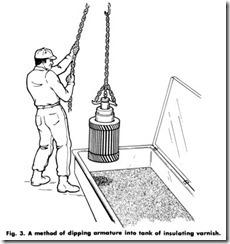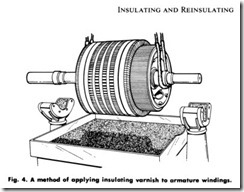Insulating And Reinsulating
Normally, the insulated windings of a motor or generator require reinsulation when they appear dry, brittle, and faded. Reinsulation, in this case takes the form of revarnishing. For small motors and genera tors use a synthetic varnish of the baking type. The windings of larger units take black baking varnish of the asphalt type. While quite satisfactory for insulating windings in small motors and generators, hard varnish should not be used for large-unit windings because of the risk of damaging the winding beyond use when it is removed from the frame. The following paragraphs give the procedure for preparing, applying, and baking both synthetic and asphalt varnishes.
PREPARATION
Prepare the varnish for application by checking its temperature, cleanliness, and viscosity.
1. Check the temperature in the tank. If the varnish is too hot, its thinning agents will dissolve and a skin will form on the surface, indicating that the varnish is too thick. A varnish that is too cold also becomes thick and does not spread well.
2. Make certain that the varnish is thoroughly mixed and free of dirt, skin, or other foreign matter. Strain the varnish through a fine wire mesh or several layers of cheese cloth if necessary.
The viscosity rate of insulating varnish must not exceed 70 seconds or be less than 20 seconds, as measured at 25°C (77°F) by viscositycup. If the varnish is too thick for a given temperature thin it with a diluting agent (thinner). Be careful not to add thinner to the varnish too rapidly lest the varnish becomes too thin for use.
Application
The most efficient method of applying insulating varnish to insulated windings is by dipping. With individual windings, this is a simple matter. However, special handling is required when dipping armatures and rotors.
1. Insulating windings. Individual windings can be insulated by simple immersion in a varnish tank, Fig. 1. Splicing connections should be prepared as shown in Fig. 2, prior to immersion.
2. Armatures and rotors. Cap, mask, or strip such parts of the armature or rotor which are to be kept free of varnish and allow sufficient time for stripping compound to dry before dipping. Suspend the armature
or rotor, with the commutator or collector-ring end up, and lower into the tank until the varnish reaches the bottom of the commutator risers, Fig. 3. Keep it immersed for about 20 minutes, or until
bubbling ceases. Subsequent dips should last about 10 minutes. If a rotor or armature is too large to be immersed, place the varnish in a pan and lower the winding, keeping the shaft horizontal, until the varnish covers the bottom of the coil slots, Fig. 4. Then rotate the winding slowly until all parts are well covered and penetrated. After pan dipping, spray varnish heavily on front and back ends of the windings and on the back of the commutator risers not covered by dipping. Drain the winding, with commutator or collector-ring end up, for at least 30 minutes, or until dripping ceases. Room temper ature should not be less than 20°C (68°F).
Baking
Windings of units of 200 horsepower or less are baked in an oven at from 130°C to 135°C (266° to 275°F). If only one dipping and one baking is required, bake the winding from 15 to 16 hours. More than
one dipping requires baking from 6 to 8 hours for each dip except the last, which needs at least 16 hours. Some windings necessitate a longer baking period in order to completely cure the varnish.
CAUTION: Make sure that the baking oven is provided with some
means of circulating air and of removing the vapors.
Number of Dips and Bakes Required
For general- purpose units up to 200 horsepower ( 149.2 kW) use 1 dip and bake for armatures, rotors, or stators with formed coils, and 2 dips and bakes for mush (random-wound) coils. When operating conditions are severe and resistance to high humidity or acid is required, stators, rotors, or armatures should be given 4 dips and bakes. For general purpose units, use 2 dips and bakes for an original winding or a rewound unit, 1 dip and bake for an old armature, not rebanded, and 2 dips and bakes for an old armature, rebanded.
REINSULATING BY PRESSURE-IMPREGNATION METHOD
Open-slot coils are, as a rule, thoroughly treated by vacuum- or pressure- impregnation or by multiple dipping and baking, before being placed into the slots. All winding material used with these coils is also treated. Therefore, except in special cases, open-slot constructions do not require pressure impregnations. When operating conditions are such that vacuum- and pressure-impregnation is advisable and the necessary equipment is available, the instructions below should be followed. Use of the process is customarily limited to railway and relatively small, high-speed motors.
Procedure
1. Place the properly supported stator, rotor, or armature into the tank.
An armature should be supported in such a manner that it will stand vertically. Cap, mask, or strip armature or rotor parts.
2. Pump varnish into the tank until the varnish is approximately 1/2 inch (12 mm) above the unit part or, in the case of an armature, until the varnish rises to about 1/4 inch (6 mm) on the commutator risers.
3. Close the lid of the tank and tighten down the lid clamps.
4. Draw nitrogen directly from the cylinder through suitable pressure reducing and regulating devices.
5. Apply the compressed nitrogen at a pressure of from 75 psi to 80 psi for from 1-1/2 to 2 hours.
6. Force the varnish back into the varnish storage tank.
7. Relieve pressure to zero psi, loosen the lid clamps, raise the lid, and remove the unit part.
8. Drain the motor or generator part for at least 30 minutes.
9. Place in the baking oven. Follow previous baking instructions.
Precautions and Gas Substitution
1. . In the absence of nitrogen gas, carbon dioxide can be used in gaseous form.
2. The use of oxygen or compressed air instead of the gases specified is exceedingly dangerous and may result in fires and explosions.
CAUTION: Threads of the valves of oxygen cylinders are the same as those of carbon dioxide cylinders, so the danger of connecting to an oxygen cylinder is present. Check before making connection.
When large volumes of carbon dioxide gas are required within a short time, position the cylinders of liquid carbon dioxide, with the valves down, and vaporize in suitable evaporating equipment.
SUMMARY
Most motors need reinsulation when their insulation windings appear dry, brittle, and faded. The windings of larger units take black baking varnish of the asphalt type. Hard varnish is satisfactory for use in small windings. The most efficient method of applying insulating varnish to insulated windings is by dipping. Armatures and rotors can also be dipped if properly handled.
Baking of dipped windings cures the varnish or insulating material. Some armatures, rotors, or coils require more than one dipping and more than one baking. The last baking is for about 16 hours and cures the varnish or insulating material.
The pressure-impregnation method of reinsulating is used to speed up the process of impregnation. It doesn’t take as long as dipping. However, it should be remembered that the pressure can become dangerous and if the wrong materials or pressure regulators are used it can mean trouble.
REVIEW QUESTIONS
1 . How can you tell when a motor or generator needs reinsulating?
2. What is used to reinsulate motors?
3. What methods are used to apply insulating materials to armatures, rotors, stators?
4. What is the most efficient method of applying insulating varnish to insulated windings?
5. What is the purpose of baking a winding after it has been dipped?



